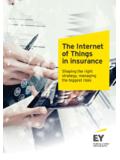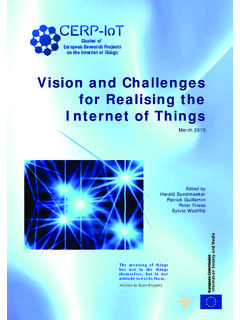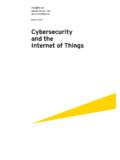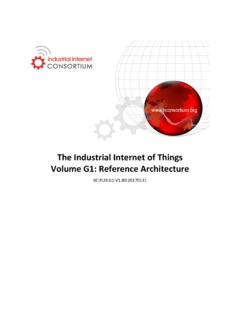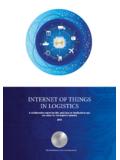Transcription of Internet of Things (IoT): A Vision, Architectural …
1 1 Internet of Things (IoT): A Vision, Architectural Elements, and Future Directions Jayavardhana Gubbi,a Rajkumar Buyya,b* Slaven Marusic,a Marimuthu Palaniswamia aDepartment of Electrical and Electronic Engineering, The University of Melbourne, Vic - 3010, Australia bDepartment of Computing and Information Systems, The University of Melbourne, Vic - 3010, Australia Abstract Ubiquitous sensing enabled by Wireless Sensor Network (WSN) technologies cuts across many areas of modern day living.
2 This offers the ability to measure, infer and understand environmental indicators, from delicate ecologies and natural resources to urban environments. The proliferation of these devices in a communicating-actuating network creates the Internet of Things (IoT), wherein, sensors and actuators blend seamlessly with the environment around us, and the information is shared across platforms in order to develop a common operating picture (COP). Fuelled by the recent adaptation of a variety of enabling wireless technologies such as RFID tags and embedded sensor and actuator nodes, the IoT has stepped out of its infancy and is the the next revolutionary technology in transforming the Internet into a fully integrated Future Internet .
3 As we move from www (static pages web) to web2 (social networking web) to web3 (ubiquitous computing web), the need for data-on-demand using sophisticated intuitive queries increases significantly. This paper presents a Cloud centric vision for worldwide implementation of Internet of Things . The key enabling technologies and application domains that are likely to drive IoT research in the near future are discussed. A Cloud implementation using Aneka, which is based on interaction of private and public Clouds is presented.
4 We conclude our IoT vision by expanding on the need for convergence of WSN, the Internet and distributed computing directed at technological research community. Keywords: Internet of Things ; Ubiquitous sensing; Cloud Computing; Wireless Sensor Networks; RFID; Smart Environments * Corresponding author. Tel.: +61 3 83441344; fax: +61 3 93481184; 1. Introduction The next wave in the era of computing will be outside the realm of the traditional desktop. In the Internet of Things (IoT) paradigm, many of the objects that surround us will be on the network in one form or another.
5 Radio Frequency IDentification (RFID) and sensor network technologies will rise to meet this new challenge, in which information and communication systems are invisibly embedded in the environment around us. This results in the generation of enormous amounts of data which have to be stored, processed and presented in a seamless, efficient, and easily interpretable form. This model will consist of services that are commodities and delivered in a manner similar to traditional commodities.
6 Cloud computing can provide the virtual infrastructure for such utility computing which integrates monitoring devices, 2 storage devices, analytics tools, visualization platforms and client delivery. The cost based model that Cloud computing offers will enable end-to-end service provisioning for businesses and users to access applications on demand from anywhere. Smart connectivity with existing networks and context-aware computation using network resources is an indispensable part of IoT.
7 With the growing presence of WiFi and 4G-LTE wireless Internet access, the evolution toward ubiquitous information and communication networks is already evident. However, for the Internet of Things vision to successfully emerge, the computing paradigm will need to go beyond traditional mobile computing scenarios that use smart phones and portables, and evolve into connecting everyday existing objects and embedding intelligence into our environment. For technology to disappear from the consciousness of the user, the Internet of Things demands: (1) a shared understanding of the situation of its users and their appliances, (2) software architectures and pervasive communication networks to process and convey the contextual information to where it is relevant, and (3) the analytics tools in the Internet of Things that aim for autonomous and smart behavior.
8 With these three fundamental grounds in place, smart connectivity and context-aware computation can be accomplished. The term Internet of Things was first coined by Kevin Ashton in 1999 in the context of supply chain management [1]. However, in the past decade, the definition has been more inclusive covering wide range of applications like healthcare, utilities, trasport, etc [2]. Although the definition of Things has changed as technology evolved, the main goal of making computer sense information without the aid of human intervention remains the same.
9 A radical evolution of the current Internet into a Network of interconnected objects that not only harvests information from the environment (sensing) and interacts with the physical world (actuation/command/control), but also uses existing Internet standards to provide services for information transfer, analytics, applications, and communications. Fuelled by the prevalence of devices enabled by open wireless technology such as Bluetooth, radio frequency identification (RFID), Wi-Fi, and telephonic data services as well as embedded sensor and actuator nodes, IoT has stepped out of its infancy and is on the verge of transforming the current static Internet into a fully integrated Future Internet [3].
10 The Internet revolution led to the interconnection between people at an unprecedented scale and pace. The next revolution will be the interconnection between objects to create a smart environment. Only in 2011, the number of interconnected devices on the planet overtook the actual number of people. Currently there are 9 billion interconnected devices and it is expected to reach 24 billion devices by 2020. According to the GSMA, this amounts to $ trillion revenue opportunities for mobile network operators alone spanning vertical segments such as health, automotive, utilities and consumer electronics.
